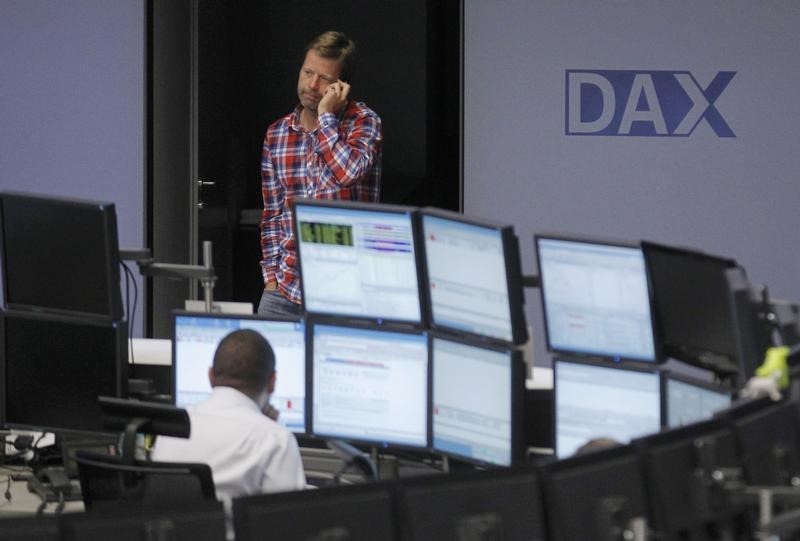* Dollar off 16-mth low on BOJ intervention talk
* European shares fall sharply, bonds surge in safety rush
* Wall Street expected to open down 1.7 percent
* Hong Kong shares lead Asia equity markets lower
* Fed's Yellen upbeat on economy, acknowledged global risks
* US yield curve flattest since late 2007
By Marc Jones
LONDON, Feb 11 (Reuters) - The dollar hit a 16-month low against the yen on Thursday to put it on course for its worst week since the Lehman crisis as investors scrambled for relative safety, buying up gold and top-rated bonds and dumping stocks.
Investors were spooked by worries over the direction of the global economy and by cautious comments from the head of the U.S. Federal Reserve that were taken to mean further rate hikes are unlikely in the near term.
Wall Street ESc1 NQc1 was expected to open almost 2 percent lower.
European stocks .FTEU3 were down over 3 percent at a 2-1/2 year low led by another 6 percent plunge in banks, and the Swedish crown SEK= tumbled as its central bank waded in with a surprise cut to its already deeply negative interest rates. this shows is that the risk-off mode has come back very quickly and that the worst may still be to come in these markets," said Rabobank European strategist Emile Cardon.
"What is different to previous times is that the bad news in now coming from everywhere, China, Portugal the U.S. the commodity sector the banking sector. It's like several smaller crises could combine into one big crisis."
There was just as much drama in the bond markets. Intense demand for ultra-safe U.S. Treasuries drove longer-term bond yields to three-year lows and flattened the yield curve in a way that has presaged economic recession in the past.
Benchmark European German Bund yields DE10YT=TWEB dropped sharply and UK yields UK10YT=TWEB hit an all-time. Traders dumped riskier Spanish, Italian, and in particular Portuguese bonds, which suffered their biggest beating in 2-1/2 years. came with euro zone's finance ministers with worries creeping back in about both Portugal and Greece's ability to stick to the terms of their bailouts.
"Portugal needs to stand ready, if necessary, to do more, to stay within the Stability and Growth Pact. I is not a unique situation, we have had it with other countries," the head of euro group Jeroen Dijsselbloem said in Brussels. was no sign of the frenetic pace easing as the start of U.S. trading and another appearance in Congress later in the day by Yellen approached.
With the dollar attempting a claw back, Britain's FTSE 100 .FTSE recovered a touch to be down 2 percent, Germany's DAX .GDAXI was 2 percent lower, though Italian .FTMIB and Greek shares .ATG both held losses of around 5 percent on their familiar banking sector and bailout worries. .EU
The flight from risk had been bumpy in Asia too. Hong Kong .HSI - a favourite channel for global investors to play China - nose dived 4.2 percent as investors there returned from the long Lunar New year holidays. Mainland China markets are closed all week.
MSCI's broadest index of Asia-Pacific shares outside Japan .MIAPJ0000PUS shed 1.4 percent, and South Korea .KS11 resumed with a 2.9 percent drop.
Wall Street had ended Wednesday mixed after Fed Chair Janet Yellen sounded optimistic on the U.S. economy, but acknowledged risks from market turmoil and a slowdown in China. took that to mean a hike in March was unlikely, but further tightening remained possible later in the year.
"Yellen made it clear that while the Fed still expects to continue on its gradual tightening path, policy was not on a pre-set course and would respond appropriately to developments," said Justin Fabo, a senior economist at ANZ.
"The real test may come later, if markets continue to deteriorate and look to central banks to save them. Are policymakers' guns loaded with blanks?"
YIELDS STEAM ROLLERED
It seemed some were already preparing for the worst.
Longer-term U.S. debt rallied hard as investors wagered that either the Fed would be unable to tighten at even a gradual pace, or that if it did hike it would only hasten the arrival of recession and deflation.
In a marked turnaround, yields on 10-year Treasuries fell to 1.5978 percent US10YT=TWEB , from a top of 1.773, and back to lows last seen at the end of 2012 when the Fed was busily printing money. Futures TYc1 imply further price gains lie ahead.
As a result, the spread over two-year paper US2YT=TWEB shrank to just 96 basis points, the smallest gap since late 2007 just before the global financial crisis hit.
Likewise, Fed fund futures 0#FF: are pricing in the shallowest of shallow tightening paths. The market implies a rate of 45 basis points for the end of this year, 60 basis points at the end of 2017 and 90 by the close of 2018.
The decline in U.S. yields continued to drag on the dollar, which reached lows last seen in October against a basket of currencies .DXY .
The yen was again lifted by safe-haven flows, as befits Japan's position as the world's largest creditor nation. The dollar shot down to 111.36 yen to depths not delved since October 2014 though the talk of BOJ inventions pushed back up to 112.60 JPY=EBS . /FRX
The euro also weakened against its Japanese peer, sliding to a 2-1/2 year low of 126.06 yen before bouncing back above 127 EURJPY=R . Against the wilting greenback, the euro drove as high as $1.1355, its highest in three months.
The aversion to risk helped lift gold XAU= as far as $1,217.00 an ounce, clearing stiff resistance around $1,200.
